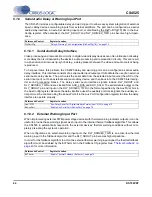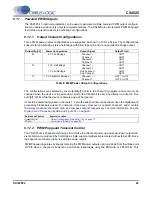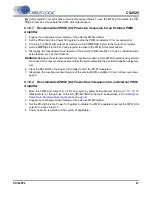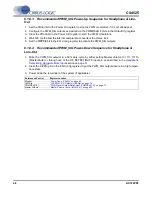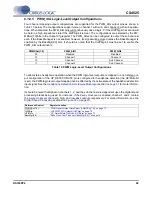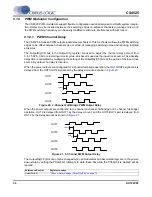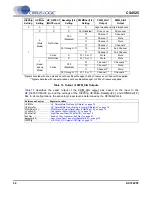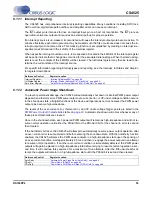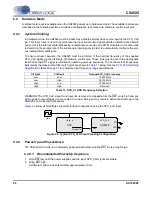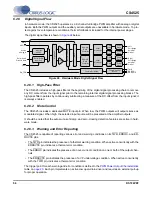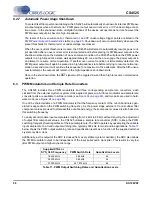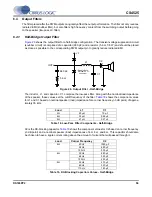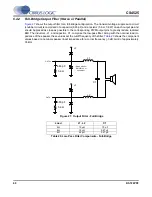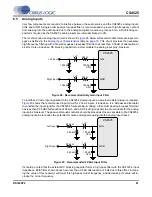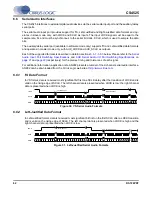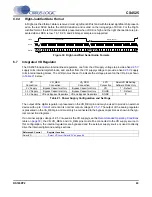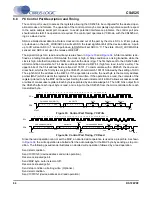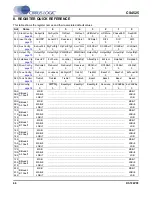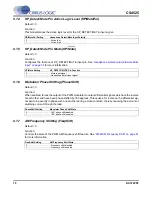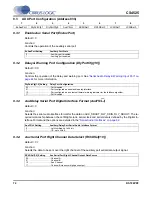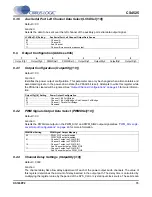
58
DS726PP2
CS4525
6.2.7
Automatic Power Stage Shut-Down
To protect itself from permanent damage, the CS4525 will automatically shut down its internal PWM pow-
er output stages when a thermal error, PWM power output over-current error, or VP under-voltage condi-
tion occurs. In the shut-down state, all digital functions of the device will operate as normal, however the
PWM power output pins become high-impedance.
The levels of the over-current error, thermal error, and VP under-voltage trigger points are listed in the
PWM Power Output Characteristics
. Shut-down will occur automatically whenever the
preset thresholds for thermal error or under-voltage are crossed.
When the over-current threshold is crossed, the CS4525 will attempt to automatically resume power out-
put operation after an over-current error is encountered and before placing its PWM power outputs in the
shut-down state. Upon the detection of an over-current condition, the CS4525 will place the PWM power
outputs in a high-impedance state, wait approximately 85 ms, and then re-engage the power outputs in
an attempt to resume normal operation. If another over-current condition is immediately detected, the
PWM power outputs will again be placed in a high-impedance state before retrying to resume normal op-
eration a second time. It will continue this sequence for a maximum of five attempts. After the fifth unsuc-
cessful attempt, the outputs will remain in the high-impedance shut-down state.
Once in the shut-down state, the RST signal must be toggled low and then high to resume normal device
operation.
6.3
PWM Modulators and Sample Rate Converters
The CS4525 includes three PWM modulators and three corresponding sample rate converters, each
clocked from the external crystal or system clock applied at power-up. All three modulator and sample rate
converter pairs are available in software mode (see
), and two pairs are used in hard-
One of the characteristics of a PWM modulator is that the frequency content of the out-of-band noise gen-
erated is dependent on the PWM switching frequency. As the power stage external LC and snubber filter
component values are used to attenuate this out-of band energy, their component values are also based on
this switching frequency.
To easily accommodate input sample rates ranging from 32 kHz to 96 kHz without requiring the adjustment
of output filter component values, the CS4525 utilizes a sample rate converter (SRC) to keep the PWM
switching frequency fixed regardless of the input sample rate. The SRC operates by upsampling the variable
input sample rate to a fixed output switching rate, typically 384 kHz for most audio applications.
below shows the PWM output switching rate and quantization levels as a function of the supplied external
crystal or system clock.
Additionally, as the output of the SRC is clocked from a very stable crystal or oscillator, the SRC also allows
the PWM modulator output to be independent of the input serial audio clock jitter. This results in very low
jitter PWM output and higher dynamic range.
Supplied XTAL or
SYS_CLK Frequency
PWM Switch Rate
Quantization Levels
18.432 MHz
384 kHz
48
24.576 MHz
384 kHz
64
27.000 MHz
421.875 kHz
64
Table 17. PWM Output Switching Rates and Quantization Levels

